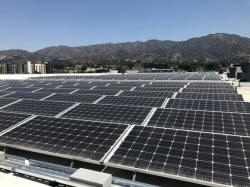|
America’s hungriest wind
and solar power users: big companies
 Send a link to a friend
Send a link to a friend
 [June 21, 2017]
By Nichola Groom [June 21, 2017]
By Nichola Groom
LOS ANGELES (Reuters) - Major U.S.
corporations such as Wal-Mart Stores Inc. and General Motors Co.
have become some of America’s biggest buyers of renewable energy,
driving growth in an industry seen as key to helping the United States
cut carbon emissions.
Last year nearly 40 percent of U.S. wind contracts were signed by
corporate power users, along with university and military customers.
That's up from just 5 percent in 2013, according to the American Wind
Energy Association trade group.
These users also accounted for an unprecedented 10% of the market for
large-scale solar projects in 2016, figures from research firm GTM
Research show. Just two years earlier there were none.
The big reason: lower energy bills.
GRAPHIC - Big companies are powering the U.S. clean energy push:
http://tmsnrt.rs/2tr9Q1Z

Costs for solar and wind are plunging thanks to technological advances
and increased global production of panels and turbines. Coupled with tax
breaks and other incentives, big energy users such as GM are finding
renewables to be competitive with, and often cheaper than, conventional
sources of electricity.
The automaker has struck deals with two Texas wind farms that will soon
provide enough energy to power over a dozen GM facilities, including the
U.S. sport utility vehicle assembly plant in Arlington, Texas that
produces the Chevrolet Tahoe, Cadillac Escalade and GMC Yukon.
The company is already saving $5 million a year worldwide, according to
Rob Threlkeld, GM's global manager of renewable energy, and has
committed to obtaining 100% of its power from clean sources by 2050.
"It's been primarily all driven off economics," Threlkeld said. "Wind
and solar costs are coming down so fast that it made it feasible."
(For a graphic showing the corporate green-energy rush, see: http://tmsnrt.rs/2spS81j
)
Growing corporate demand for green energy comes as U.S. President Donald
Trump is championing fossil fuels and targeting environmental
regulations as job killers. This month he announced the United States
will withdraw from the landmark Paris Agreement to fight climate change,
a move that was condemned by several prominent U.S. executives,
including General Electric Co Chief Executive Jeff Immelt.

Trump’s administration, however, has made no moves to target federal tax
incentives for renewable energy projects, thanks mainly to bipartisan
support in Congress. Many Republican lawmakers hail from states that are
major solar or wind energy producers, among them Texas, Oklahoma and
Iowa.
U.S. companies, meanwhile, are pursuing their own clean-energy agendas
independent of Washington politics. Over the past four years,
corporations have contracted for about 7 gigawatts of renewable energy –
enough to power more than 1 million homes. That number is expected to
rise to 60 GW by 2025, according to the Edison Foundation Institute for
Electric Innovation, a utility-backed non-profit based in Washington
D.C.
Growth in renewables for years was driven by utilities laboring to meet
tough state mandates to reduce carbon emissions, particularly in places
such as California. Early corporate adopters included Alphabet Inc <GOOGL.O>
and Amazon.com Inc <AMZN.O>, leading-edge companies with progressive
company cultures, deep pockets and major power needs.
Now mainstream industries are stepping in as costs have plummeted.
Wind-power costs have dropped 66% since 2009, according to the American
Wind Energy Association, while the cost to install solar has declined
70% since 2010, according to the Solar Energy Industries Association
trade group.
This year alone, home improvement retailer Home Depot Inc <HD.N>,
wireless provider T-Mobile US Inc <TMUS.O>, banker Goldman Sachs and
food producer General Mills <GIS.N> announced major purchases of
renewable energy.
POWER TO THE PPA
Such deals can take many forms, but most are so-called power purchase
agreements. Known as PPAs, these are roughly 10-to-20-year contracts in
which the owner of a large solar or wind project sells electricity to
large customers, often at rates lower than those charged by utilities.
These agreements allow energy users to buy renewables at attractive
prices with no upfront investment.
[to top of second column] |

A rooftop panel system is shown on the roof of a new IKEA store in
Burbank, California, U.S., June 19, 2017. Photo taken June 19, 2017.
REUTERS/Nichola Groom

These agreements also help companies avoid outages if the sun doesn't shine or
the wind doesn't blow. The massive wind farms and solar plants that support
these contracts often supply electricity straight to the grid rather than feed
it directly to corporate customers' plants and offices. Companies get the
benefit of clean energy without cutting themselves off from the security of the
grid.
The arrangement also saves companies from having to do it all themselves. Mark
Vanderhelm, vice president of energy for Wal-Mart, said the retailer is about
half way to its goal of sourcing 50% of its power from renewable sources by
2025. While the chain has installed solar panels atop hundreds of stores, it has
purchased much of its green energy via two PPAs.
"For us to meet our goals, we wouldn't be able to get there by doing it all on
site. We just fundamentally don't have enough roof space," Vanderhelm said.
He said Wal-Mart is seeing roughly single-digit percentage savings with its
green-power contracts.
Furniture retailer IKEA is a notable exception to the PPA trend, preferring to
own the renewable-energy assets that serve its U.S. business, including rooftop
solar systems on most of its buildings and two wind farms in Texas and Illinois.
The approach is part of the Swedish company's long-term corporate strategy of
owning all of its stores, factories and the land on which they're built.

Demand from big corporations has benefited a host of wind and solar developers
including Pattern Energy <PEGI.O>, First Solar <FSLR.O> and NextEra Energy <NEE.N>.
BNB Renewable Energy Holdings LLC, a privately held New York-based developer,
said corporations now make up about half its business.
"There is a convergence right now where price is low and their sustainability
commitments are high," said Jos Nicholas, a managing partner with BNB.
The developers or owners of the projects, meanwhile, get the stability of
long-term contracts plus those federal tax breaks. The solar credit is worth up
to 30 percent of a project's value. For wind, the most popular tax credit is a
maximum of 2.4 cents per kilowatt-hour of electricity produced for a decade.
AMBITIOUS GOALS
Since 2014, nearly 100 large global companies have committed to transitioning to
100% renewables through a partnership with The Climate Group, a nonprofit that's
working to reduce greenhouse gas emissions. Roughly two corporations a month are
joining that effort, according to Amy Davidsen, the organization's executive
director for North America.
In addition to GM, U.S. companies that have made the commitment include Johnson
& Johnson, Procter & Gamble Co <PG.N> and Nike Inc <NKE.N>.
Still, many big firms remain on the sidelines because they lack an overall
corporate sustainability mandate, view renewables as having unattractive returns
or because the contracts are too long, according to a 2016
PricewaterhouseCoopers survey.

Many small- and medium-sized businesses have a hard time benefiting too. They
don't consume enough energy to negotiate large, lowest-cost PPAs like the big
guys. Smaller projects, such as installing rooftop solar panels, tend to depend
heavily on state and local incentives that come and go.
The 2020 expiration of the federal tax incentives is another concern. But
industry watchers expect U.S. companies will continue their ambitious public
commitments to boost renewable energy use even if those breaks aren't renewed.
General Mills, for instance, sees climate change as a major threat to the
agricultural supply chain behind products such as Cheerios cereal and Yoplait
yogurt. The company has a goal of reducing its greenhouse gas emissions by 28
percent by 2025.
"If the front end of that business model breaks down -- Mother Nature -- we're
in a world of hurt," Lynch said.
(Editing by Marla Dickerson)
[© 2017 Thomson Reuters. All rights
reserved.] Copyright 2017 Reuters. All rights reserved. This material may not be published,
broadcast, rewritten or redistributed. |